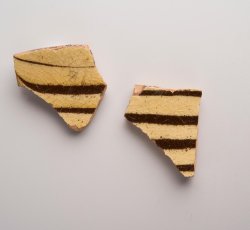Body - Page 3 of 4


Tin-glazed earthenware blue painted hollowware.
Refined Earthenware | Object #: 1695087
Possible cup.
Explore This Item
Possible tin-glazed earthenware ointment pot.
Refined Earthenware | Object #: 1695099
Explore This Item



Tin-glazed earthenware vessel with Chinoiserie motif.
Refined Earthenware | Object #: 1695568
Possible base. British or Dutch.
Explore This Item
Colonoware bowl.
Coarse Earthenware | Object #: 1721197
Unlike many of the other ceramics excavated from areas of Mount Vernon, this fragment was made locally of an earthenware called colonoware. Colonoware is an unglazed coarse earthenware fired at a low temperature, which is hand-built from local clays, rather than thrown on a potter’s wheel. The ...
Explore This Item
Coarse earthenware unidentified.
Coarse Earthenware | Object #: 1721775
Large limestone inclusions.
Explore This Item
Possible Iberian Redware unidentified body fragment
Coarse Earthenware | Object #: 1721781
Mica, limestone, gravel inclusions.
Explore This Item
Redware mug/can.
Coarse Earthenware | Object #: 1722066
Slightly mottled exterior and interior glaze. Measurements taken from largest mended portion.
Explore This Item

Red-bodied, black glazed holloware vessel.
Coarse Earthenware | Object #: 1722186
Mottled glaze. Wall curvature similar to mug/can.
Explore This Item
Staffordshire slipware trailed dish or plate.
Coarse Earthenware | Object #: 1722281
This fragment is a ceramic archaeologists refer to as North Midlands/Staffordshire type slipware. The word “type” is used here to denote the fact that coarse, slip decorated wares were actually produced in several regions of England throughout the seventeenth and eighteenth century. One feature...
Explore This Item
Staffordshire slipware trailed and combed dish or plate.
Coarse Earthenware | Object #: 1722283
This fragment is a ceramic archaeologists refer to as North Midlands/Staffordshire type slipware. The word “type” is used here to denote the fact that coarse, slip decorated wares were actually produced in several regions of England throughout the seventeenth and eighteenth century. One feature...
Explore This Item
Staffordshire slipware trailed and combed dish or plate.
Coarse Earthenware | Object #: 1722392
This fragment is a ceramic archaeologists refer to as North Midlands/Staffordshire type slipware. The word “type” is used here to denote the fact that coarse, slip decorated wares were actually produced in several regions of England throughout the seventeenth and eighteenth century. One feature...
Explore This Item
Staffordshire slipware trailed and combed dish or plate.
Coarse Earthenware | Object #: 1722407
This fragment is a ceramic archaeologists refer to as North Midlands/Staffordshire type slipware. The word “type” is used here to denote the fact that coarse, slip decorated wares were actually produced in several regions of England throughout the seventeenth and eighteenth century. One feature...
Explore This Item
Staffordshire slipware marbled dish or plate.
Coarse Earthenware | Object #: 1722414
This fragment is a ceramic archaeologists refer to as North Midlands/Staffordshire type slipware. The word “type” is used here to denote the fact that coarse, slip decorated wares were actually produced in several regions of England throughout the seventeenth and eighteenth century. One feature...
Explore This Item
Staffordshire slipware flatware.
Coarse Earthenware | Object #: 1722436
This fragment is a ceramic archaeologists refer to as North Midlands/Staffordshire type slipware. The word “type” is used here to denote the fact that coarse, slip decorated wares were actually produced in several regions of England throughout the seventeenth and eighteenth century. One feature...
Explore This Item
Staffordshire slipware marbled dish or plate.
Coarse Earthenware | Object #: 1722437
This fragment is a ceramic archaeologists refer to as North Midlands/Staffordshire type slipware. The word “type” is used here to denote the fact that coarse, slip decorated wares were actually produced in several regions of England throughout the seventeenth and eighteenth century. One feature...
Explore This Item